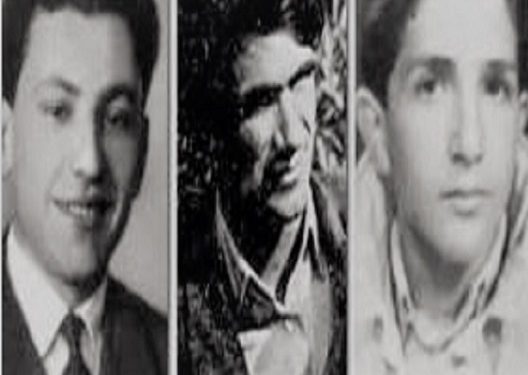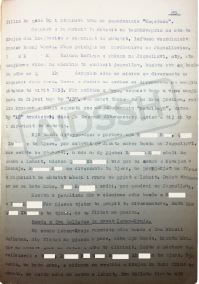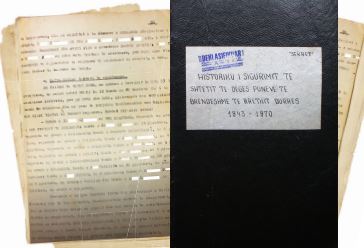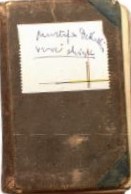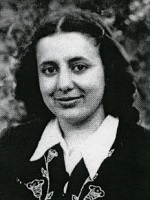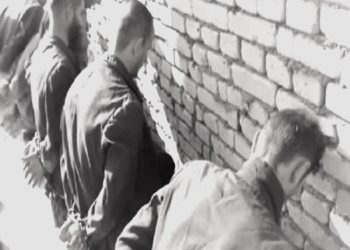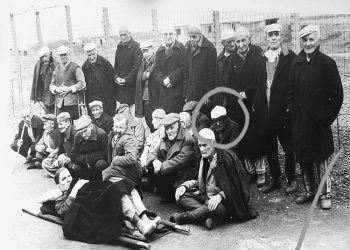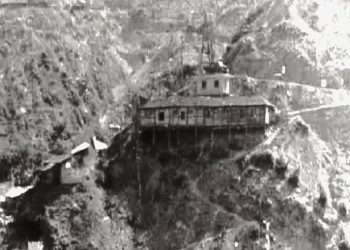The first part
Memorie.al/ publishes a study conducted by AIDSSH (Authority for the Information of Former State Insurance Documents), entitled “DISAPPEARED – INSURANCE IN OWN WORDS”, 19 INSURANCE BRANCH, 3299 JETH, 1 HISTORY’, in which was used the “History of the State Security”, which belongs to a period of time from 1943 to 1991, which includes 19 branches of the State Security, from the districts: Durrës, Kolonje, Burrel, Krujë, Lushnje, Dibër, Gramsh, Pogradec, Korçë, Tepelën, Elbasan, Lezhë, Sarandë, Gjirokastër, Vlorë, Shkodër, Tropoje, Skrapar, Librazhd and Tirana.
Entry
INSURANCE IN OWN WORDS
“Those who think that communist regimes are the work of criminals only, overlook a fundamental truth: criminal regimes were not formed by criminals, but by convinced enthusiasts…”!
Milan Kundera, “The unbearable lightness of being”
Opponents of the communist regime, former politicians, former collaborators of the Security, citizens who become part of the list of enemies, fugitives, clergy, former party secretaries, former ministers, artists, journalists and intellectuals, are found in the Historians of the former Security State, with a common denominator: victims of totalitarianism. No one ever was safe.
Therefore, the order to live takes on the meaning of the order to save life, often even at the cost of other lives, reformulating Primo Levi’s question: “Is he really human”?! Behind this duality and an amorphous mass that is powerfully silent, lies the history of a people, in more than four decades, which, through the Historians of the former State Security, is a calendar of murders, shootings, liquidations, annihilations and no less prisons and exiles.
They are the black stains that our society carries over time. Until yesterday secret documents, through the history written by the winners, are now summaries where they document their deeds. They are our black spots. For the construction of this exposition, the histories of the 19 branches of the former State Insurance in the country have been reviewed, from the reading of which they result; 510 killed by State Security, mentioned by name in the respective historians and 470 killed without a name, who in the history appear in figures alongside others, defined as such: others.
The research for this exhibition, evidences persons for whose execution, State Security assumes the authorship, in documents produced by him in the years 1973-1980, as it is claimed, worked carefully and edited scientifically. The documents span a wide period, which suggests that the activity of the Security has its beginnings since the Second World War, charging it with acts and actions against political opponents, even before the installation of the communist system in the country.
But should the State Security documents be taken for granted and should the information of these historians be treated as exhaustive? Of course not. Historians, as documents drawn up by the secret police structure of the system, unfold a summary of information, worked out in a period when the Security was consolidated and aimed at presenting events in a certain light.
In the histories declassified in the years 2019-2021 by the Authority, State Security assumes the authorship of some events, simultaneously giving its own point of view on the names involved. The secret police admit that they have fought or eliminated in some ways the political opponents, who are referred to by the terms saboteurs, war criminals, enemies of the people, saboteurs, spies, bandits, kulaks and others, in clashes with whom, there are casualties from both the parties.
All this, through the first-hand testimonies of the Security, which also stops at the place of executions, but without exact coordinates. A list drawn up in the Ministry of the Interior, before the communist regime fell, counts 3,031 people killed without trial in the country. The Institute of the Former Political Persecuted calculates in its data, 106 women executed or dead in prison.
Today, family members can request clarification of the fate of their relatives, according to the scope of the law 45/2015, amended, on missing persons. The study of the 19 historians at this stage is only the beginning, with this exhibition that encourages researchers to open all the documents, to delve into the research in the archives and to present all sides of history, for those tried in communism, those punished without trial, the dead in the investigator and others who still today need to be revealed and recognized for their true activity.
This exhibition, opened on the International Day of the Disappeared, aims to narrate the victims of communism, limiting itself to the victims that appear in history, evidenced considering that – through different names, known or unknown, – the total of summarizes the methods of State Security harassment over the years, the methods used to catch opponents, from the invention of diseases, to the ‘combinations’ accepted by the Security employees themselves, through legends that imply the spread of fake news, “lightning investigators “, when it is accepted that “a hand was given”, of the traps, shedding light around the circle, on the ways in which the recruitment of collaborators was done under duress, through pressure with the arrest of family members, or the confrontation with the child tied head to toe in the cell.
This exhibit is not their full story, but it is the version of history according to State Security, written by him and accepted by him. In the documents shown or quoted, the terminology used for political opponents, arrested or killed, is harsh. They are labeled as; criminals, spies, traitors to the homeland, degenerate or with low morals, so reading this documentation requires very special care, and the awareness that they contain strong stratifications of communist ideology.
Security speaks with the language of power, with the political approach of the time, for which man is important as a living body, commendable and manipulable by it. As a dead body, he served only to frighten political opponents, when he was used as a “trophy” that was displayed in kalash squares, in front of crowds, or in photographs, to frighten those who were in the investigation, such as Kokomani’s images, Lezho of Koprencka, who was put in front of Fatos Lubonja. The missing remain black spots…!
Black spots are the endless waiting before the future has yet arrived. This exhibition aims to give all the shades of black, from south to north, to present with the documents of State Security itself, hundreds of human destinies in the same place. This exhibition is to understand that black spots are still black…! For Hannah Arendt, “terror becomes total, when it becomes independent of any kind of opposition; he rules supremely, when no one stands in his way. If lawfulness is the essence of non-tyrannical government and lawlessness is the essence of tyranny, then terror is the essence of totalitarian rule!
History of the State Security for the district of Durrës, 1943 – ’44
In the history written by the employees of the Security before the fall of communism, a series of sensational and dark events of the time are documented, executions that were left without perpetrators, as well as the methods that were used for the surveillance, dismantling, or annihilation of the “enemies of the people”. At the beginning of 1945, when the installation of the Albanian left-wing totalitarianism began, with the elimination of political opponents, the State Security, or the People’s Protection Divisions, counted Durrës’ fugitives, divided into 12 groups with 89 members, which calls them “gang” and “thugs”.
The informational structure that had begun to become the stalking shadow of the political opponents of the regime, the associations of individuals with more than 3 people, with tendencies against the system, qualifies as “gangs”, while among them, there were “gangs” with up to 18 members.
From the top, among the enemies of the government, the groups made up of former leaders and members of the ‘National Front’, ‘Legality’ or “collaborators” of the invaders are mentioned as “gangs”, such as: Xhemal Gjergjit, with three members, Xhemal Gjokës, with 13 members, Mustafa Deliallisi with 6, Zyber Kokomani with 3, Ymer Keqit with 5 people, Tom Gallatës with 3, Bajram Vorës with 18 members, Sali Gjini with 2 and Myrteza Çopa with 3 members, who were later destroyed or escaped. The aim of the government was to eliminate them, since they were not only opponents, but also posed a risk of rebellion.
The elimination of “gangs” would be followed by the discovery of anti-government groups in every sector, city or village, until the tendency for “debauched life” found in rock and roll music or the desire to see a ship. Since taking power and continuing, State Security carried out recruitment of collaborators in the Railway, Port, Shipyard, Fishing, Tire Industrial Enterprise, Reclamation, Agricultural Mechanical Plant, Cigarette Industrial Enterprise, Farm, Car-Tractor Station, Automotive Park of Goods, etc. But everything started, with “all the people”, who brought information, according to State Security.
Sleeping bullet…!
Tom Nikollë Gallata, an opponent of the communist regime, went on the run in the first days of liberation. The security calls him the head of a gang that operated in the Ishëm – Krujë area. It managed to survive hidden for almost 6 years, despite constant efforts to eliminate it.
In April 1950, the decision was made to destroy him, along with his entire “gang” and, if not possible, to ambush him alone and kill him. The security managed to insert his associate “Kaçatura” into Tom Gallata’s group. One evening, in the forest of Manza in Durrës, “Kaçatura” captures another member of the group, V.T., escaped but shaken.
“Toma and Gjergji were asleep, while three others (from the group) had gone to Kruja, to kill D.M., with all his children. On the night of April 7, 1950, they were annihilated, they killed Tom Gallata and Gjergji, and the other three were annihilated that same night, by the State Security forces, without managing to commit the crime mentioned above.” With the murder in his sleep, State Security manages to prove the loyalty of “Kaçatura”, about whom he had doubts.
Safe wait, for the former partisan
Ram Habili, the son of a former Zog officer, had been a partisan in the Myslim Peza detachment, until a clash with Kajo Karafili, made him switch to the “National Front”. In 1944, when the war was ending, he was declared an enemy and went to the mountains where he managed to survive until 1951. Wounded, he fell into the hands of the State Security from the trap of a collaborator. “He was accompanied by the special group of the State Security bodies with a donkey, to take him to the ‘organization headquarters’, taking his rifle as well. He was caught and taken to the hospital, where he was treated and recovered.”
The purpose of the bodies was to recruit Ram Habili, a man of influence, as a collaborator against some important groups, but he managed to escape. Since Habil was aware of a phantom “organization” run by State Security, operatives saw the risk of deconspiracy, so they decided to liquidate it. “He was put in a safe ambush, near the village of Gjinaj in Kavaja, and on June 23, 1951, he was killed.”
From his family, 5 children and two elderly women died in exile, while his brother lost his mental abilities due to torture.
The assassination of the former Prime Minister
08:00, October 11, 1943, commercial district, Durrës. Former Deputy Prime Minister Idhomen Kosturi leaves the house and heads towards the car that would take him to Tirana. He is shot and falls dead.
A few days ago, the Germans had chosen to appoint him as the head of the assembly (Parliament) as an uncompromised person. A large businessman in Durrës who, according to the Security Historian, “had become extremely rich during the occupation”, the Party Circuit decided that he “would not be able to go to Tirana to start work, but be killed”, so after a few days under observation, is executed near his home.
Educated in Boston for history, knowledgeable of several foreign languages, participant in the Congress of Elbasan, that of Durrës and Lushnja, prime minister in 1921 and deputy prime minister of Noli in 1924, Sigurimi describes him only as a merchant and gives the above date for his execution. (The history of Durrës Security is a document prepared in 1977).
– Murder or suicide of the former commander?!-
In the regime’s efforts to eliminate opponents, the former commander of the Shijak Gendarmerie, Mustafa (bey) Deliallisi, was among the most important in Durrës. Although he had been a friend of Myslim Peza and Kajo Karafil, the persecution of his tribe had started very early, with 7 killed, from 1944 to 1948, of which two were Mustafa’s brothers and he himself 1948.
Hiding in the area of Shijak with 6 opponents of communism, the History of Security does not clarify how Mustafa Deliallisi was reached, or the place where he was ambushed, but only informs about the murder. “Mustafa Deliallisi was surrounded by the State Security forces and after a resistance, he was killed. A notepad was also found with him, in whom he wrote in the form of a diary and a part of his activity”.
His granddaughter confessed that Mustafa Delialiasi, after burning the documents, committed suicide in her house on December 18, in order not to fall into the hands of the communists who had surrounded him. His body was exposed for three days in Shijak
Social-democratic “gang”.
In the plane of political thought, the Communist Party had eliminated, during the War and after it, political thought otherwise, organized in a party or without becoming a party. While representatives of the social-democratic thought escaped, like Isuf Luzaj, or were in prison, like Musine Kokalari.
At the beginning of the 1960s, during the period of aggravation of relations with the Soviet Union, the history of State Securityspeaks of the tracking of a new social-democratic group. The first to report to the Security authorities is the “Assistant” and after him the “Assistant’s” brother, the “Volunteer”.
The first suspicions that haunted the group started from the statement of Z.K. (according to State Security, a vagabond and adventurer), that the days of power are numbered. The “assistant” dismantled his friendly circle, which also included Pjetër Arbnori, whose father was killed by a guerrilla unit, for whom, in 1961, the long ordeal began.
The “reactionary group”, as described by the Historian of the Security, which had appointed 2 brothers to follow them, included, besides Mr. K. and Pjetër Arbnori, also Tanush Kason, Uran Kalakula, etc. When it was learned that Pjetër Arbnori and Z.K. were going to Tirana to the meeting of the group as representatives of Durrës, the “Volunteer” agent was instructed to meet with Z.K. and learn when they would leave, what they would travel with, and where they would hide the program.
He learned that they would travel to Tirana by train, and they would also receive a copy of the Party’s program. The “volunteer” had seen that Zeqiri had put the program in the inside pocket of his jacket and he had told him that Pjetri also had a copy with him.
“They were under constant surveillance and after the associate informed the operative, they were acted upon by catching Pjetri on the street and Z.K. In work. A copy of the program of the “social-democratic party” was found during the search, and based on this material and the denunciation that S.R. had made, they were arrested. The Ministry was notified to act on the other group in Tirana, and they were arrested within the day. In this way, the anti-revolutionary organization was also eliminated from the State Security bodies of the Durrës district”.
Political rock and roll
“In the conditions of a debauched, adventurous life, mixed with foreign ideology from a bad family and social environment”. From the middle of 1962, the “Sputnik” agent reported to State Security that; “a group of young people in different houses organized family evenings and there they danced and sang wildly, like jazz songs, twist again, rock and roll, etc. and indirectly expressed hatred towards life in our country, etc”.
The information is taken very seriously by the operational sector, which started reviewing the biographies of what it describes as a “hostile group” with a tendency to escape. At the head was 19-year-old Njazi Luli, proficient in English, former employee at the steamship agency, middle-class, unmarried and student at the Shkodër Pedagogical Institute.
State Security notices the tendency to escape in the desire of young people “with a bad political background and attitude” to “secretly board the steamers of the revisionist capitalist states, but they handed them over because they were afraid of being dictated to”! Memorie.al
The next issue follows




